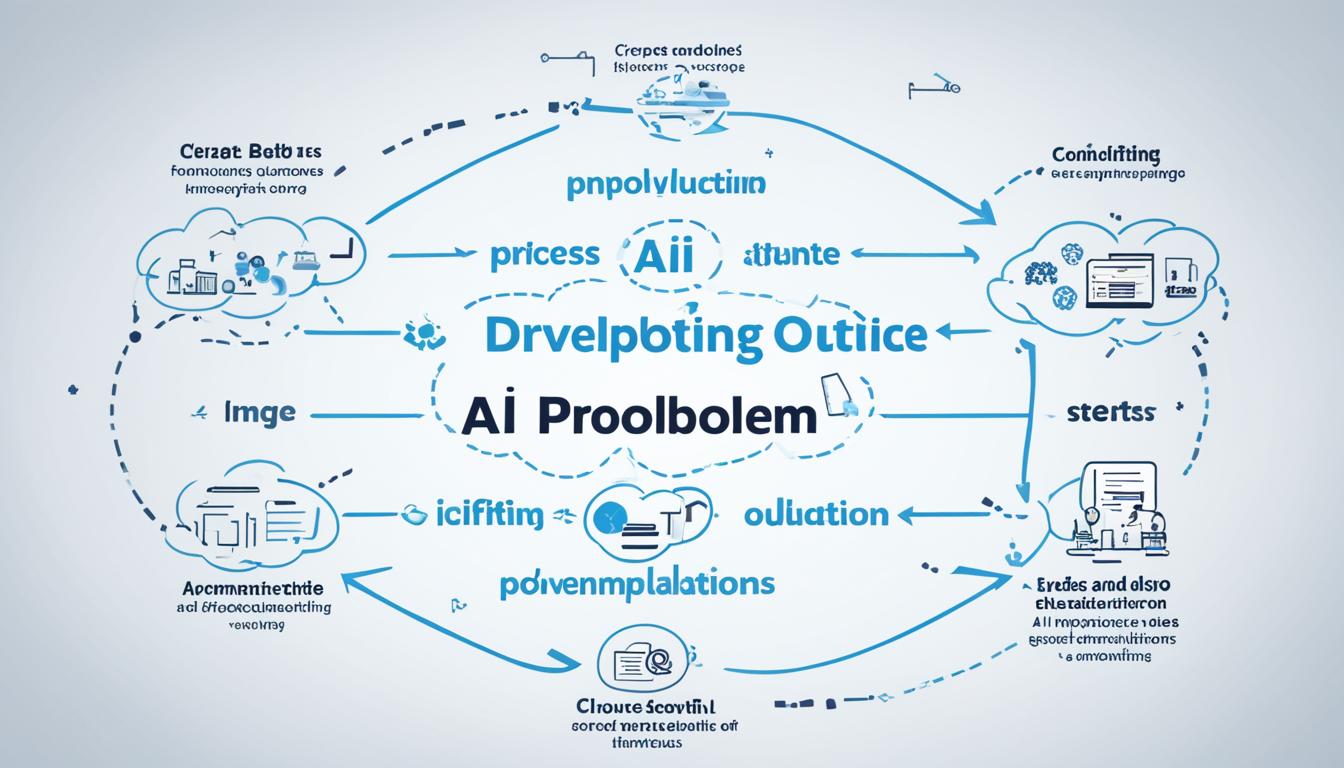In artificial intelligence, problem formulation is the process of identifying, analyzing, and defining the problems that need to be solved using AI techniques. It involves breaking down complex problems into smaller, more manageable components and formulating a clear problem statement. Problem formulation plays a crucial role in shaping efficient and smart solutions in the field of AI. It helps AI agents define the goals, initial state, actions, transitions, and goal test required to solve a problem. By understanding the basics of problem formulation in AI, you can gain insights into the techniques and algorithms used to solve various problems in artificial intelligence.
Contents
Key Takeaways
- Problem formulation is the process of identifying, analyzing, and defining the problems in artificial intelligence.
- It involves breaking down complex problems into smaller, more manageable components.
- Problem formulation helps AI agents define the goals, initial state, actions, transitions, and goal test required to solve a problem.
- Understanding problem formulation is essential for implementing problem-solving techniques in AI.
- Various techniques and algorithms are used in problem formulation to solve problems in artificial intelligence.
The Three Types of Problems in AI
In the domain of artificial intelligence, there are three types of problems: ignorable, recoverable, and irrecoverable. Understanding these problem types is crucial in determining the appropriate problem-solving techniques and algorithms to be applied.
Ignorable problems are those where certain solution steps can be ignored without affecting the final outcome. These problems usually involve redundant or unnecessary actions that can be omitted in the solution process.
Recoverable problems, on the other hand, are those where solution steps can be undone or reversed if needed. This type of problem allows for flexibility in the problem-solving process, as mistakes or incorrect steps can be rectified along the way.
Irrecoverable problems are the most challenging type, as the solution steps cannot be undone once executed. This means that careful consideration and analysis must be undertaken before taking any action, as there is no turning back.
Examples of problem formulation in artificial intelligence can include tasks such as:
- Pathfinding: Finding the optimal route from one point to another in a given environment.
- Constraint Satisfaction: Satisfying a set of constraints or conditions while searching for a solution.
- Optimization: Maximizing or minimizing a specific objective within a given set of constraints.
By understanding the different types of problems in AI and their corresponding examples, you can approach problem formulation and problem-solving with a clear strategy and direction, optimizing your chances of finding effective solutions.
| Type of Problem | Description | Example |
|---|---|---|
| Ignorable | Solution steps can be ignored without affecting the final outcome. | Redundant or unnecessary actions in a problem-solving process. |
| Recoverable | Solution steps can be undone or reversed if needed. | Rectifying mistakes or incorrect steps during problem-solving. |
| Irrecoverable | Solution steps cannot be undone once executed. | Careful consideration and analysis required before taking any action. |
Steps for Problem Solving in AI
Problem-solving in AI is a multi-step process that allows you to tackle complex problems using various techniques and algorithms. By understanding and following these steps, you can effectively solve problems in the field of artificial intelligence.
Step 1: Problem Definition
Problem definition is the first crucial step in problem-solving. It involves clearly specifying the inputs and acceptable system solutions for the given problem. By defining the problem accurately, you provide a solid foundation for finding the right solution.
Step 2: Problem Analysis
Once the problem is defined, the next step is to analyze it thoroughly. This involves examining the problem from different angles, identifying any patterns or underlying factors, and gaining a deeper understanding of its complexity. Problem analysis helps you uncover valuable insights that can guide your problem-solving approach.
Step 3: Knowledge Representation
Knowledge representation involves collecting detailed information about the problem and exploring possible techniques and algorithms for solving it. By understanding the available resources and methodologies, you can choose the most effective approach to tackle the problem at hand.
Step 4: Problem-Solving
Once you have analyzed the problem and gathered the necessary knowledge, it’s time to apply problem-solving techniques. This step involves selecting the best techniques and algorithms based on the problem’s characteristics and constraints. By using the right tools, you increase the chances of finding an optimal solution.
Step 5: Formulating Associated Problem Components
To achieve the desired goal, it’s crucial to formulate the associated problem components. This includes defining the initial state, actions, transitions, goal test, and path costing required to solve the problem effectively. By carefully formulating these components, you create a structured framework that aids in problem-solving.
Understanding these steps is essential for implementing problem-solving techniques in AI. By following a systematic approach and leveraging the power of AI algorithms, you can overcome complex challenges and find innovative solutions.

| Step | Description |
|---|---|
| Step 1 | Problem Definition |
| Step 2 | Problem Analysis |
| Step 3 | Knowledge Representation |
| Step 4 | Problem-Solving |
| Step 5 | Formulating Associated Problem Components |
Problem-Solving Approaches in AI
In the field of artificial intelligence, there are various approaches to problem-solving. These approaches utilize different algorithms and techniques to tackle complex problems and find effective solutions. Three common problem-solving approaches in AI include heuristic algorithms, searching algorithms, and genetic algorithms.
Heuristic algorithms are used to experiment and test different procedures in order to understand the problem and generate a solution. While they may not always provide the optimal solution, heuristic algorithms offer effective short-term methods for achieving goals. By leveraging prior knowledge and experience, these algorithms can guide problem-solving processes and provide valuable insights.
Searching algorithms are fundamental techniques used by rational agents or problem-solving agents to find the most appropriate solutions. These algorithms involve creating and exploring a search space to identify the desired solution. By systematically traversing the search space, searching algorithms can efficiently navigate through complex problem domains and identify potential solutions. They play a crucial role in solving problems such as pathfinding, constraint satisfaction, and optimization tasks.
Genetic algorithms are inspired by evolutionary theory and natural selection. These algorithms employ a population-based approach and simulate the natural process of evolution to solve problems. By generating and evolving populations of potential solutions, genetic algorithms mimic genetic variation, selection, and reproduction to find optimal or near-optimal solutions. Genetic algorithms are particularly effective in solving complex problems with multiple variables and constraints.
Understanding these problem-solving approaches is essential in selecting the most suitable technique for a given problem in artificial intelligence. Whether utilizing heuristic algorithms, searching algorithms, or genetic algorithms, each approach offers unique benefits and trade-offs. By leveraging these approaches, AI practitioners can develop intelligent systems and applications capable of solving complex problems effectively and efficiently.
| Approach | Description |
|---|---|
| Heuristic Algorithms | Experiment and test procedures to understand the problem and generate a solution. Effective short-term methods for achieving goals, but not always optimal. |
| Searching Algorithms | Fundamental techniques used by rational agents to find the most appropriate solutions. Create and explore a search space to identify the desired solution. |
| Genetic Algorithms | Inspired by evolutionary theory, use natural selection to solve problems. Generate and evolve populations of potential solutions based on fitness criteria. |
Note: The table above summarizes the main characteristics of each problem-solving approach in AI.

Conclusion
Problem formulation is a critical component of problem-solving in artificial intelligence. By identifying, analyzing, and defining the problems that need to be solved using AI techniques, you can lay the foundation for efficient and smart solutions. Through problem formulation, AI agents can define clear goals, initial states, actions, transitions, and goal tests required to achieve the desired outcome.
To successfully solve problems in AI, it is essential to follow the steps for problem-solving in AI. These steps include problem definition, problem analysis, knowledge representation, problem-solving, and formulation of associated problem components. By systematically going through these steps, you can gain a deep understanding of the problem and select the most suitable techniques to solve it.
Various problem-solving approaches, such as heuristic algorithms, searching algorithms, and genetic algorithms, can be applied in AI. Heuristic algorithms allow for experimentation and testing, offering effective short-term methods for achieving goals. Searching algorithms explore a search space to find the most appropriate solutions, while genetic algorithms generate and evolve potential solutions based on fitness criteria.
In conclusion, problem formulation and problem solving in AI play a vital role in shaping the field of artificial intelligence. By applying these techniques and approaches, intelligent systems and applications can be developed to tackle complex challenges and improve our lives.
FAQ
What is problem formulation in artificial intelligence?
Problem formulation in artificial intelligence is the process of identifying, analyzing, and defining the problems that need to be solved using AI techniques. It involves breaking down complex problems into smaller components and formulating a clear problem statement.
What are the three types of problems in AI?
The three types of problems in AI are ignorable, recoverable, and irrecoverable. Ignorable problems are those where certain solution steps can be ignored without affecting the final outcome. Recoverable problems are those where solution steps can be undone if needed. Irrecoverable problems are those where solution steps cannot be undone.
What are the steps for problem solving in AI?
The steps for problem solving in AI include problem definition, problem analysis, knowledge representation, problem-solving, and formulation of associated problem components. Problem definition involves specifying the inputs and acceptable system solutions, while problem analysis entails analyzing the problem thoroughly. Knowledge representation involves collecting detailed information about the problem, and problem-solving is the selection of the best techniques to solve the problem. Formulating the associated problem components includes defining the initial state, actions, transitions, goal test, and path costing.
What are the problem-solving approaches in AI?
The problem-solving approaches in AI include heuristic algorithms, searching algorithms, and genetic algorithms. Heuristic algorithms experiment and test procedures to generate a solution, searching algorithms involve creating and exploring a search space, and genetic algorithms generate and evolve populations of potential solutions based on fitness criteria.
What is the role of problem formulation and problem solving in AI?
Problem formulation and problem solving in AI play a vital role in shaping efficient and smart solutions. Problem formulation helps AI agents define the goals, initial state, actions, transitions, and goal test required to solve a problem, while problem solving techniques and approaches enable the development of intelligent systems and applications in the field of artificial intelligence.




